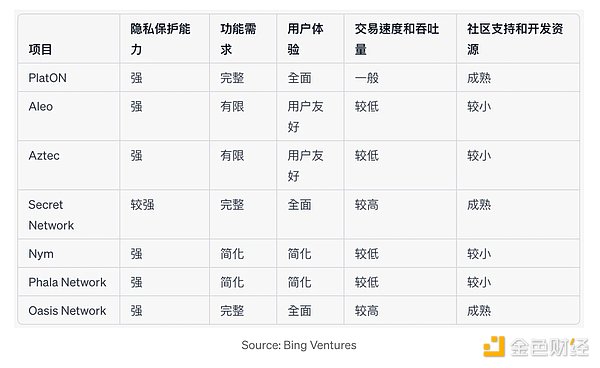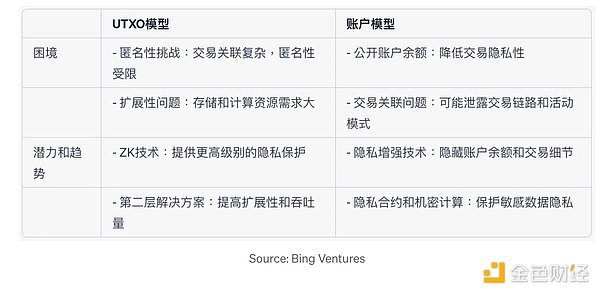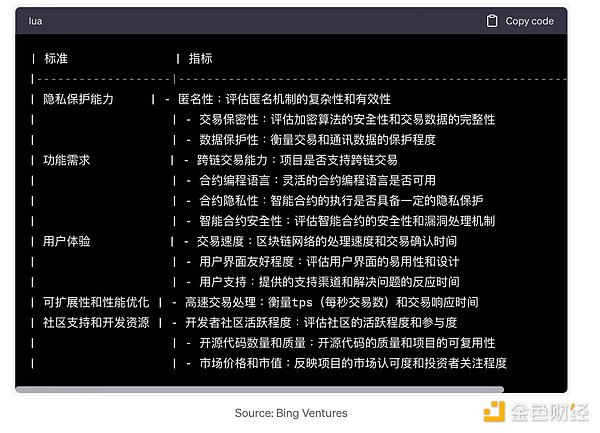Author: Kyle Liu, Bing Ventures Investment Manager
Introduction: In the rapid development of the privacy public chain market, UTXO and account system solutions have become the focus of attention. However, for the choice of these two options,we need to conduct more in-depth critical thinking and analysis to explore their adaptability in the future evolution of needs.
Currently, the privacy public chain is mainly divided into two parts: the privacy computing network and the privacy transaction network. The privacy computing network uses secure multi-party computing technology to achieve multi-party collaborative computing and protect data privacy. Among them, projects such as PlatON and Phala Network have performed well. The privacy transaction network is committed to protecting user privacy and providing higher security in transactions, such as projects such as Aztec and Iron Fish. The privacy public chain has unique advantages in protecting data privacy and transaction privacy, and plays an important role in decentralization and security. With the development of the privacy public chain market, UTXO and account system solutions have become the focus of attention. However, we need to think more deeply about the pros and cons of these options and how they will respond to evolving needs in the future.
UTXO and account model analysis
In the blockchain, UTXO and account models are Common ledger models. The UTXO model treats each transaction as a collection of inputs and outputs, providing better privacy protection by embedding additional content in the output script. It has the advantages of reducing transaction verification time and cost, protecting privacy, and improving transaction throughput. However, the complexity of UTXO model verification poses some challenges, especially in terms of scalability and efficiency in large-scale networks.
In contrast, the account model is relatively simple in management and suitable for implementing token transfers and smart contract execution. However, the account model may compromise user privacy because accounts are part of the global state. To sum up, both UTXO and account models have advantages and challenges in terms of privacy protection and security. For the UTXO model, we need to consider its scalability and efficiency in large-scale networks, as well as the overhead of storage and verification. For the account model, we need to address global state and privacy issues while taking into account the computational resources and time costs of transaction verification.

p>
Privacy of account model VS privacy of UTXO model
It is worth noting that UTXO and account model Different dilemmas exist when it comes to protecting transaction privacy. The traditional UTXO model splits transactions to increase the difficulty for attackers to obtain specific payment information, and has certain advantages in transaction privacy. However, this model has limitations in terms of scalability and flexibility. In contrast, the account model has advantages in handling complex smart contracts and state management. Therefore, in privacy public chain projects, methods of combining these two models can be explored to achieve a better balance of privacy protection and functional requirements.
But since UTXOs are not self-contained, they rely on the functionality of previous transactions, which increases the complexity of verification because each transaction depends on needing to be verified. Previous transactions, which may involve verification of multiple blocks. This increases the storage and verification overhead of the blockchain network. Nodes need to build UTXO sets when synchronizing with the network. Once a node has verified the block header it is currently working on, it simply looks for the output in the UTXO set. This approach simplifies the verification process, but the security and risk assumptions of the node become more important as the node approaches the miner node.
To sum up, regarding the current development of "UTXO" and "account" systems, we can put forward the following views:
There are certain challenges in the complexity of UTXO model verification, and its scalability and efficiency in large-scale networks need to be considered.
The account model has some problems in terms of global state dependence and privacy. The privacy extension technology of the UTXO model can provide better privacy. Protect.
The construction and verification process of the UTXO model may increase the overhead of network storage and verification.
Taken together, the UTXO model is more widely used in privacy public chains because it can better protect transactions privacy. The account system is more suitable for scenarios that require high readability, such as ordinary transfer scenarios. When choosing a ledger model, a privacy public chain needs to choose based on its own application scenarios and weigh the needs for privacy and readability.

p>
Future demand evolution
In the future evolution of demand for privacy public chains, we need to think about how to Balance privacy protection and functional requirements. One possible solution is to combine UTXO and account models to take advantage of their respective strengths. By introducing the concept of accounts into the UTXO model, we can achieve better privacy protection and provide rich functional support. However, this hybrid model also faces technical implementation and design challenges. We need to delve deeper into how to balance and integrate between the two models to achieve better user experience and security.
We should also consider the sustainability of privacy public chain projects. Strong community support and development resources are critical to the long-term success of the project. An active developer community can bring more innovation and technological progress, providing strong support for the future development of the project. Therefore, we should evaluate factors such as the activity of the project's developer community and the quality and quantity of open source code. These indicators can help us judge the sustainability and development potential of a project. We need to comprehensively consider multiple indicators such as privacy protection capabilities, functional requirements, user experience, transaction speed and throughput, as well as community support and development resources. Only by comprehensively assessing the strengths and weaknesses of a project can we more accurately judge its long-term competitiveness.
In short, privacy public chain projects face important challenges and opportunities in the future evolution of needs. UTXO and account system solutions are one of the key factors, affecting the security, scalability, performance and user experience of the public chain. By deeply thinking about the advantages and disadvantages of UTXO and account models, and exploring the possibility of hybrid models, we can build a more competitive and forward-looking privacy public chain project while balancing privacy protection and functional requirements. Investors should pay attention to details and consider all aspects when evaluating projects to make informed decisions.

p>
Alternative innovation
For the UTXO model, by applying ZK technology and building Layer2 solutions, A higher level of privacy protection and improved transaction throughput and efficiency can be achieved. For the account model, through technologies such as ring signatures and zero-knowledge range proofs, account balances and transaction details can be hidden, providing stronger privacy protection. In addition, in order to overcome the respective limitations of UTXO and account models, some alternatives have emerged. One option is the hybrid model, which combines the advantages of UTXO and account models. Some emerging blockchain projects have also explored other architectures, such as state machine-based or resource-based models. These new models attempt to address the limitations of existing models and provide new solutions in terms of privacy, performance, and functionality.

p>
Market performance is not equal to user demand
There is currently a voice that believes that for most users , privacy is not the most urgent need, so it will be more reasonable to sink privacy applications into the underlying framework of mainstream blue-chip protocols. Users do not need to perceive or prioritize privacy options. But I would say that the development of privacy applications is not limited to hackers and a few institutions. With the development of blockchain technology and the continuous expansion of application scenarios, more and more people are beginning to realize the importance of privacy.
Therefore, providing better privacy protection solutions, whether through privacy plug-ins or privacy public chains, has its rationality and market demand. For example, the design based on Tornado Cash does introduce regulatory and KYC risks to a certain extent. However, this does not mean that combining privacy with KYC is ineffective. On the contrary, adopting appropriate KYC mechanisms and compliance measures can balance the needs of privacy and regulation to a certain extent. By establishing trusted KYC providers and an effective regulatory framework, a balance between privacy protection and anti-money laundering can be achieved.
Try to introduce account abstraction into UTXO
In the traditional UTXO model, each transaction are treated as a set of unused outputs that can be used as inputs for new transactions. This model has advantages in ensuring the immutability and integrity of transactions, but can be relatively complex for users and developers to use. The concept of "Account Abstract" is introduced to transform the UTXO model into a form closer to the traditional account model to provide a more simplified user experience and developer tools. Under this abstract model, users can have their own accounts without paying attention to the input and output of each transaction.
However, introducing "Account Abstract" into the UTXO model may face some challenges and dilemmas:
Increased complexity: Applying account abstraction to the UTXO model may increase the complexity of the system. In order to achieve account abstraction, new mechanisms need to be introduced to track the balance and status of accounts while ensuring the correctness and consistency of transactions. This may require significant changes to the existing UTXO model, increasing the complexity of system development and maintenance.
Privacy protection issue: In the UTXO model, the input and output of the transaction are clearly visible, and the transaction can be tracked and analyzed. . However, the introduction of account abstraction may reduce the privacy of transactions. Account abstraction may make transaction patterns and correlations more obvious, putting user privacy at risk.
Compatibility and migration costs: Introducing account abstraction into the existing UTXO ecosystem requires compatibility and migration costs to be considered. This involves compatibility with existing UTXO wallets, exchanges and smart contracts, as well as a migration process for users and developers. If the introduction of account abstraction results in incompatibility with the existing ecosystem, additional effort may be required to balance compatibility with improved performance.
In summary, UTXO and account systems each have advantages and disadvantages in the blockchain. Choosing an appropriate architecture should be based on comprehensive considerations such as the needs of specific application scenarios, privacy protection requirements, transaction speed and throughput requirements, as well as development and user experience. In the future, with the development of blockchain technology, we believe that more new architectural solutions will emerge to solve the limitations of existing models.
 JinseFinance
JinseFinance





